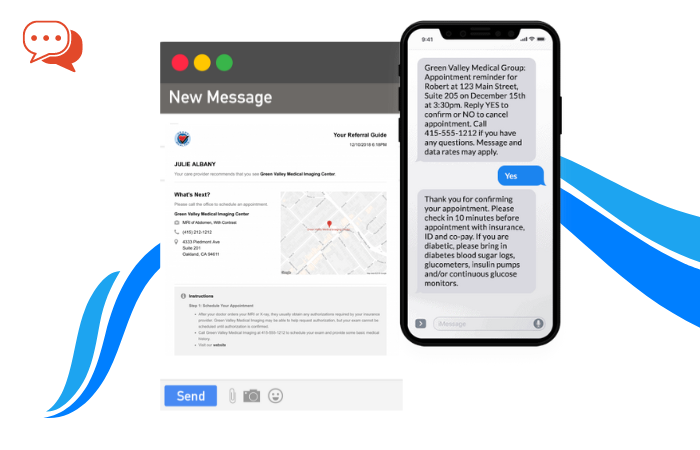In recent years, the healthcare industry has undergone a transformation driven by digital technologies. One significant aspect of this transformation is implementing a healthcare digital front door. The digital front door refers to the virtual entry point that connects patients with healthcare providers, allowing them to access services and communicate with their healthcare team online.

Photo by fancycrave1 on Pixabay
Advisory firm IDC defines the digital front door as “all the touchpoints where providers and payers can digitally interact with patients or members to drive better access, engagement, and experiences across the service continuum.”
How the Healthcare Digital Front Door Improves Office Efficiency
While the digital front door offers numerous benefits to patients and providers, one of its most significant impacts is improving office efficiency. Here are some key ways the healthcare digital front door enhances office efficiency in the medical practice:
Streamlined Appointment Scheduling
Gone are the days when patients would spend hours on the phone scheduling appointments or waiting in long queues at healthcare facilities. The digital front door provides patients with the convenience of online appointment scheduling. Accessing the provider’s website or patient portal allows patients to view available time slots, choose a suitable appointment time, and book it in minutes. This eliminates the need for extensive back-and-forth communication, reducing administrative burden and freeing up staff time for other essential tasks.
Reduced Administrative Workload
The administrative burden on healthcare offices can be overwhelming, with staff often performing repetitive and time-consuming tasks such as paperwork, data entry, and compiling patient information. With the digital front door, many of these tasks can be automated or handled directly by patients. For instance, patients can fill out electronic forms, update their medical history, and upload relevant documents before their appointment. This saves time and ensures the accuracy and completeness of information, reducing the chances of errors and the need for manual data entry.
Enhanced Communication and Care Coordination
Efficient communication is vital for a healthcare office to run smoothly. The digital front door improves patient, provider, and staff communication and care coordination. Secure messaging platforms and telehealth solutions enable real-time communication, allowing patients to ask questions, clarify doubts, or request prescription refills without needing an in-person visit or phone call. This provides patients with timely responses and reduces the volume of phone calls, allowing staff to focus on higher-priority tasks.
Improved Patient Engagement and Empowerment
Engaged and empowered patients are more likely to actively participate in their healthcare actively, leading to better health outcomes. The digital front door empowers patients by providing convenient access to their health records, test results, and personalized educational resources. Patients can review their medical information, track their progress, and take proactive steps toward well-being. This self-service approach reduces unnecessary office visits, thus freeing up appointment times for patients with more complex needs.
Enhanced Workflow Efficiency
The healthcare digital front door streamlines workflow and improves overall office efficiency by leveraging digital tools and technology. For instance, electronic health records (EHR) integrated with the digital front door allow seamless sharing of patient information between providers, reducing the need for duplicate tests and improving care continuity. Additionally, automation of administrative tasks and data analytics can help identify bottlenecks in the workflow, enabling the office to make informed decisions and implement process improvements.
Referral Management and the Digital Front Door
Benefits for Patients
With healthcare referral management solutions, patients experience improved access to specialized care. They no longer need to worry about lengthy phone calls or misplaced paperwork. Referrals can be initiated electronically, making the process faster, more convenient, and less stressful. Patients can view their referral status, receive appointment reminders, and even communicate with specialists through secure messaging platforms, promoting continuity of care.
Benefits for Healthcare Providers
For healthcare providers, these solutions offer increased efficiency, reduced administrative burden, and improved collaboration among healthcare teams. Patient information is easily accessible, allowing providers to make informed decisions and provide personalized care. Automated workflows and electronic communications accelerate the referral process, ensuring patients receive timely and appropriate care. Overall, healthcare referral management solutions empower providers to deliver a higher standard of care while optimizing their resources.
While healthcare referral management solutions and the digital front door are not universally adopted, their potential to transform the referral process is undeniable. As technology evolves, it becomes increasingly important for healthcare organizations to explore these innovative solutions to enhance patient care, streamline operations, and improve overall healthcare experiences.
The healthcare digital front door has revolutionized how patients access healthcare services and engage with their providers. The digital front door significantly boosts office efficiency by streamlining appointment scheduling, reducing administrative workload, enhancing communication and care coordination, empowering patients, and improving workflow efficiency. Embracing these digital solutions benefits the healthcare provider by saving time and resources, enhancing the patient experience, and ultimately improving patient outcomes.












